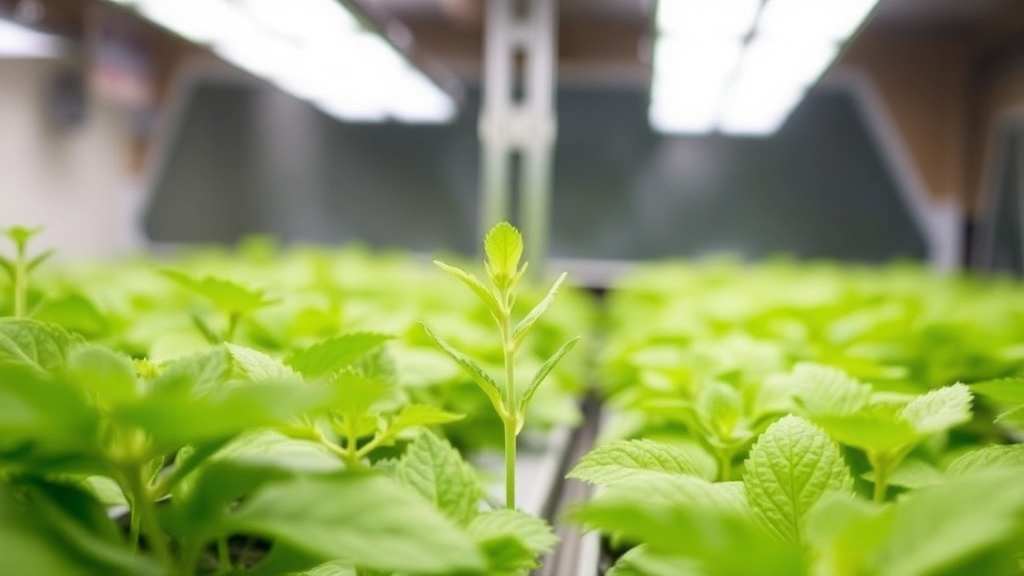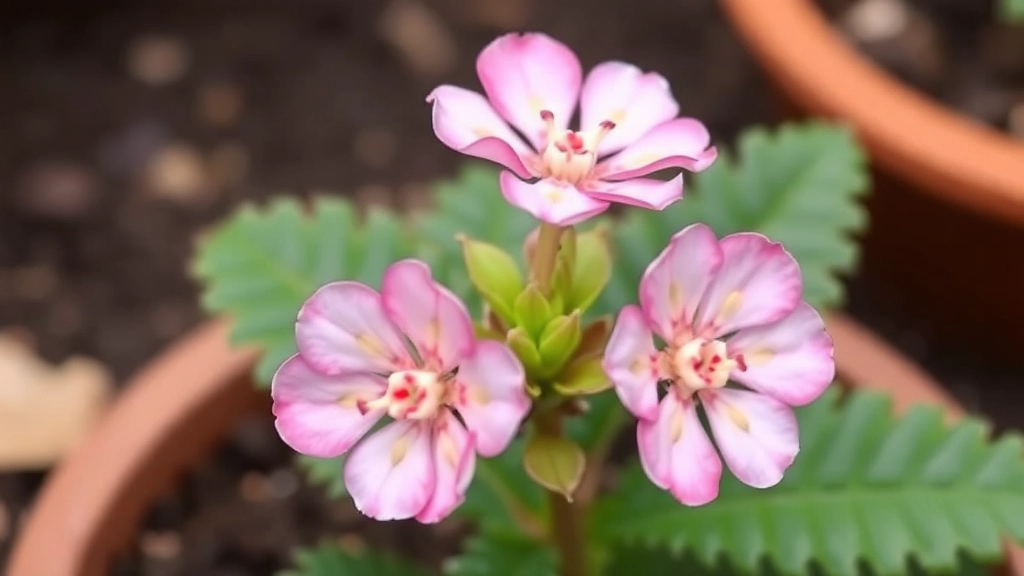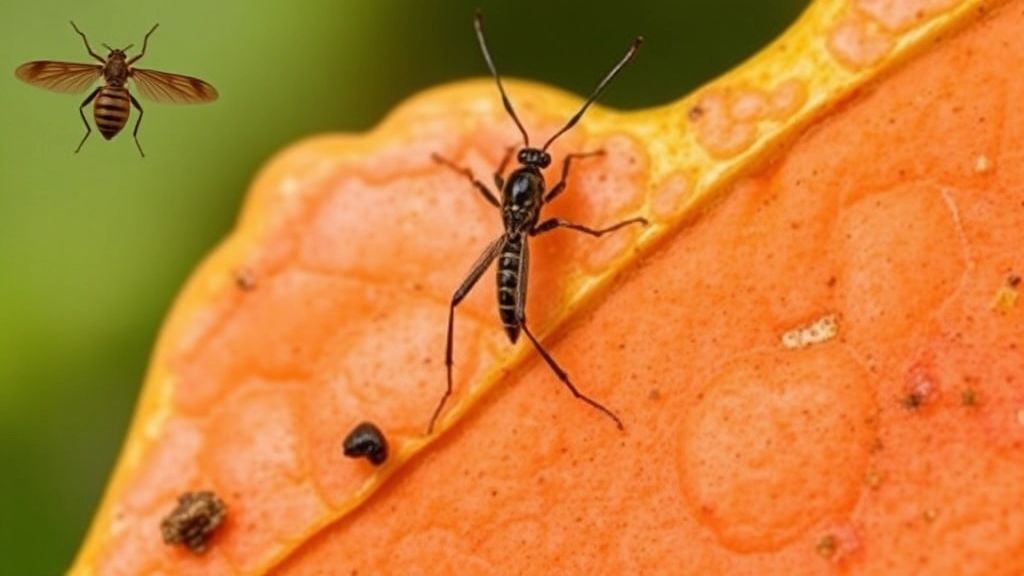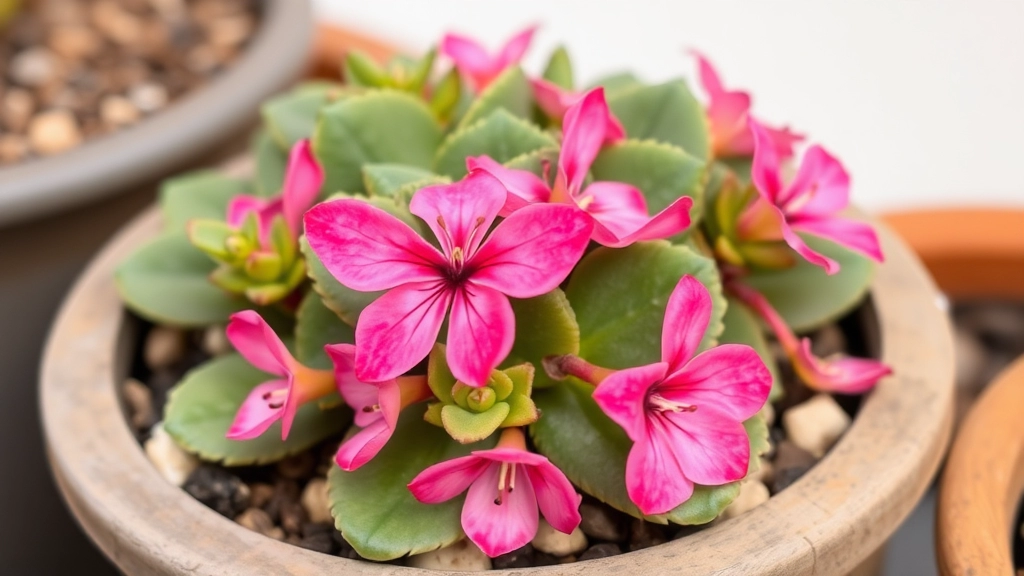Kalanchoe Pink Butterflies Succulent Guide
If you’re captivated by the unique charm of the Kalanchoe Pink Butterflies Succulent, you’re not alone. This stunning plant is a favourite among succulent enthusiasts, thanks to its eye-catching pink plantlets that resemble delicate butterflies. In this guide, I’ll share essential care tips, propagation methods, and everything you need to keep your Kalanchoe thriving.
Key Characteristics
Understanding the key characteristics of the Kalanchoe Pink Butterflies Succulent is the first step towards successful cultivation. From ideal growing conditions, including light and temperature, to watering best practices and choosing the right soil, I’ll cover it all. Plus, I’ll delve into effective propagation techniques, common pests and diseases, and tips for repotting. Whether you’re growing this beauty indoors or outdoors, these insights will help you maintain a healthy, vibrant plant.
Are you looking for a unique and vibrant succulent to brighten up your space? Kalanchoe ‘Pink Butterflies’ might just be the perfect choice for you.
This stunning plant is known for its distinctive, butterfly-shaped leaves that boast a delightful pink hue.
## Unique Features
– **Leaf Shape**: The leaves are not only shaped like butterflies but also have a serrated edge, adding texture to the plant.
– **Color**: As the name suggests, the leaves exhibit a captivating pink colour, especially when exposed to bright light.
– **Growth Habit**: Typically, this succulent grows upright, making it an eye-catching addition to any collection.
## Size and Care
– **Height**: It can reach up to 30 cm (12 inches) tall, making it a manageable size for both indoor and outdoor settings.
– **Care Level**: Kalanchoe ‘Pink Butterflies’ is relatively low-maintenance, perfect for both seasoned gardeners and beginners.
This plant not only adds aesthetic appeal but also offers a sense of tranquility and warmth to your home or garden. For more detailed care instructions, you can refer to the [complete guide to caring for Kalanchoe ‘Pink Butterflies’](how-to-care-for-pink-butterflies-kalanchoe-succulent/). Additionally, if you’re interested in other varieties, check out this [guide on 150 species of Kalanchoe succulent plants](discover-150-species-of-kalanchoe-succulent-plants/).
Ideal Growing Conditions: Light and Temperature

So, you’ve got your Kalanchoe ‘Pink Butterflies’ and you’re wondering how to keep it thriving, right? The secret really lies in nailing the right light and temperature.
Light Requirements
These beauties love bright, indirect sunlight. Here’s how to get it right:
- Location: Place your Kalanchoe near a south or west-facing window.
- Duration: Aim for about 6 hours of light daily. Too little, and it may become leggy; too much direct sun can scorch those lovely leaves.
- Signs to Watch: If the leaves start to stretch out, it’s a sign they’re reaching for more light. If they’re losing colour, they might be getting too much sun.
Temperature Needs
Kalanchoe ‘Pink Butterflies’ are pretty chill, but they do have their preferences:
- Ideal Range: Keep them between 18-24°C (65-75°F).
- Nighttime Chill: They can handle cooler nights, but try not to drop below 10°C (50°F).
- Avoid Sudden Changes: These plants don’t like drastic temperature shifts, so keep them away from drafts or heating vents.
By ensuring your Kalanchoe gets the right light and temperature, you’ll set the stage for vibrant growth and those stunning leaves to shine.
After understanding the ideal growing conditions for Kalanchoe ‘Pink Butterflies’, let’s delve into one of the most crucial aspects of succulent care: watering.
### Understanding Watering Needs
Many succulent owners often worry about overwatering or underwatering their plants.
Kalanchoe ‘Pink Butterflies’ thrives on a careful balance. Here are some essential tips to ensure your plant remains healthy and vibrant:
– **Frequency**: Water your Kalanchoe every 2-3 weeks during the growing season (spring and summer). In winter, reduce this to once a month.
– **Soil Check**: Always check the soil before watering. Insert your finger about an inch into the soil; if it feels dry, it’s time to water. If it’s still moist, wait a few more days.
– **Watering Technique**: Use the soak-and-dry method. Water thoroughly until it drains from the bottom, then allow the soil to dry completely before the next watering.
– **Avoid Water on Leaves**: Be mindful not to let water sit on the leaves, as this can lead to rot.
– **Signs of Overwatering**: Yellowing leaves, mushy stems, or a foul smell can indicate overwatering. Adjust your watering schedule accordingly.
### Additional Considerations
Consider the environment where your Kalanchoe is placed.
Factors such as humidity, temperature, and light exposure can all influence how often you need to water.
For example, a plant in a bright, warm spot will require more frequent watering than one in a cooler, shaded area. For more detailed care tips, you might find the [complete guide to growing and caring for Kalanchoe Pink Butterflies](https://planthq.org/complete-guide-to-growing-and-caring-for-kalanchoe-pink-butterflies/) particularly useful.
Additionally, if you’re dealing with any specific issues like yellowing leaves or mushy stems, you might want to check out the [fixing etiolated Kalanchoe Blossfeldiana: lighting and care tips](https://planthq.org/fixing-etiolated-kalanchoe-blossfeldiana-lighting-and-care-tips/) for more targeted advice.
Choosing the Right Soil for Kalanchoe ‘Pink Butterflies’

When it comes to nurturing your Kalanchoe ‘Pink Butterflies’, selecting the right soil is crucial for its overall health and growth. You might be wondering, what type of soil best supports these vibrant succulents?
Key Soil Characteristics
Kalanchoe ‘Pink Butterflies’ thrive in well-draining soil. Here are some essential characteristics to consider:
- Drainage: Ensure the soil allows excess water to escape. This prevents root rot, a common issue for succulents.
- Texture: A gritty or sandy texture is ideal. This mimics their natural habitat, allowing air circulation around the roots.
- pH Level: Aim for slightly acidic to neutral pH levels (around 6.0 to 7.0) to promote optimal nutrient absorption.
Recommended Soil Mixes
You can create a perfect blend for your Kalanchoe by mixing:
- Potting Soil: Start with a quality potting mix as a base.
- Perlite or Pumice: Add 30-50% perlite or pumice to enhance drainage.
- Cactus Mix: Alternatively, a pre-made cactus mix can work wonders.
Tips for Soil Maintenance
- Check for Compaction: Over time, soil can compact, reducing drainage. Refresh your mix every couple of years.
- Avoid Heavy Soils: Stay away from regular garden soil, as it retains too much moisture.
Effective Propagation Techniques for Maximum Growth
When it comes to propagating Kalanchoe ‘Pink Butterflies’, many enthusiasts often wonder about the best methods to ensure their plants thrive. This succulent is not only visually appealing but also relatively easy to propagate, making it a rewarding choice for both beginners and seasoned gardeners.
Propagation Methods
- Leaf Cuttings:
- Select healthy leaves from the parent plant.
- Allow the cut ends to dry for a few days to form a callus.
- Place the leaves on well-draining soil, ensuring the cut ends are in contact with the soil.
- Water sparingly until roots develop.
- Stem Cuttings:
- Cut a healthy stem just below a leaf node.
- Let the cutting dry for a few days to form a callus.
- Plant the cutting in a pot with succulent soil.
- Water lightly and keep in bright, indirect light.
- Offsets:
- Look for small offsets or “pups” that grow around the base of the plant.
- Gently separate these from the parent plant.
- Replant them in their own pots with suitable soil.
Tips for Successful Propagation
- Timing: The best time to propagate is during the growing season (spring to early summer).
- Humidity: Maintain a humid environment to encourage root growth, but avoid overwatering.
- Light: Provide bright, indirect sunlight to help the new plants establish.
By employing these propagation techniques, you can effectively grow new Kalanchoe ‘Pink Butterflies’ and expand your collection. For more detailed guidance, check out our step-by-step guide on propagating Kalanchoe Blossfeldiana cuttings. Additionally, if you’re interested in other Kalanchoe varieties, our guide to top Kalanchoe succulent varieties and care tips can be very helpful.
Common Pests and Diseases and How to Handle Them

So, you’ve got your Kalanchoe ‘Pink Butterflies’ thriving, but what happens when those pesky pests or diseases come knocking?
Common Pests to Watch For:
- Mealybugs: These little white critters can be a nightmare. They suck the sap from your plant, causing stress and stunted growth.
- Aphids: Tiny and often green, aphids can multiply quickly. They also feed on sap and can leave a sticky residue.
- Spider Mites: These are almost invisible but can create fine webbing on your plant. If you notice yellowing leaves, it might be time to inspect closely.
Common Diseases:
- Root Rot: This is a result of overwatering. If your plant starts wilting despite adequate watering, check the roots. They should be firm, not mushy.
- Powdery Mildew: A white, powdery substance on leaves indicates this fungal issue. It thrives in high humidity and poor air circulation.
Handling Pests and Diseases:
- Regular Checks: Make it a habit to inspect your plant weekly. Catching issues early makes all the difference.
- Neem Oil: A natural pesticide that works wonders on pests like mealybugs and aphids. Just mix with water and spray on affected areas.
- Isolate Affected Plants: If you find pests, separate the affected plant to prevent spreading.
- Remove Infected Leaves: Snip off any leaves showing signs of disease. This helps to keep the plant healthy.
- Proper Watering: To prevent root rot, ensure your pot has drainage holes and let the soil dry out between waterings.
Repotting your Kalanchoe ‘Pink Butterflies’ can feel daunting, but it’s essential for keeping your plant vibrant and thriving. You might be wondering, “When is the right time to repot?” or “How can I ensure my plant stays healthy after repotting?” Let’s break it down.
### When to Repot
– **Timing**: The best time to repot is during the spring or early summer when the plant is actively growing.
– **Signs**: Look for roots coming out of the drainage holes or if the plant seems top-heavy. These are clear indicators that it’s time for a new pot.
### Steps for Repotting
1. **Choose the Right Pot**: Select a pot that is 1-2 inches larger in diameter than the current one. Ensure it has good drainage holes.
2. **Prepare the Soil**: Use a well-draining succulent mix. You can also mix standard potting soil with sand or perlite for improved drainage.
3. **Remove the Plant**: Gently take the plant out of its old pot. Be careful not to damage the roots.
4. **Inspect the Roots**: Trim any dead or rotting roots with clean scissors. This promotes healthier growth.
5. **Position the Plant**: Place the plant in the new pot, ensuring it sits at the same depth as in the old pot.
6. **Fill with Soil**: Add fresh soil around the roots, pressing down lightly to eliminate air pockets.
7. **Watering**: Wait a week before watering to allow the roots to settle in.
### Maintaining Healthy Plants
– **Light**: Ensure your Kalanchoe gets bright, indirect sunlight. Too much direct sun can scorch the leaves.
– **Watering Routine**: Allow the soil to dry out completely between waterings. Overwatering is a common mistake. For more detailed tips, check out [Kalanchoe Tomentosa Watering Best Practices](https://planthq.org/kalanchoe-tomentosa-watering-best-practices-tips/).
– **Fertilising**: Use a diluted succulent fertiliser during the growing season to encourage robust growth.
– **Humidity**: Kalanchoe ‘Pink Butterflies’ prefers low humidity levels, so keep it in a well-ventilated area. For more information on maintaining healthy plants, visit our [Complete Care Guide for Kalanchoe Blossfeldiana Succulent](https://planthq.org/complete-care-guide-for-kalanchoe-blossfeldiana-succulent/).
Indoor vs. Outdoor Growing: Best Practices for Kalanchoe ‘Pink Butterflies’

So, you’ve got your Kalanchoe ‘Pink Butterflies’ and you’re wondering where it’ll thrive best—inside your home or out in the garden?
Indoor Growing Tips
Growing indoors can be a fantastic option, especially if you live in a cooler climate. Here’s what to keep in mind:
- Light: Aim for bright, indirect sunlight. A south or west-facing window is ideal.
- Temperature: Keep your home between 18-24°C (65-75°F). Avoid cold drafts and sudden temperature changes.
- Humidity: Kalanchoe prefers drier air, so don’t worry about humidity levels.
Outdoor Growing Tips
If you’re considering outdoor growth, here’s how to ensure your ‘Pink Butterflies’ flourish:
- Sunlight: They love full sun! Aim for 6 hours of direct sunlight daily.
- Temperature: Ideal temperatures are similar to indoors but ensure they’re protected from frost.
- Soil: Use well-draining soil to prevent root rot, especially after rain.
Key Considerations
- Seasonal Changes: Bring your plant indoors if temperatures dip below 10°C (50°F).
- Pests: Outdoor plants can attract pests. Keep an eye out for aphids and mealybugs.
Whether you choose to grow your Kalanchoe indoors or outdoors, the key is to provide the right conditions for it to thrive.
Styling and Display Ideas for Kalanchoe ‘Pink Butterflies’ in Your Home or Garden
When considering how to showcase your Kalanchoe ‘Pink Butterflies’, it’s essential to think about both aesthetics and the plant’s specific needs. You might be wondering how to best display this stunning succulent in a way that highlights its unique features while ensuring it thrives.
FAQs for Kalanchoe ‘Pink Butterflies’ Succulent
What are the ideal light conditions for Kalanchoe ‘Pink Butterflies’?
Kalanchoe ‘Pink Butterflies’ thrives in bright, indirect sunlight. Place your plant near a south or west-facing window and aim for about 6 hours of light daily. If the leaves start to stretch, it’s a sign they need more light. Conversely, if they lose color, they might be getting too much direct sunlight.
What temperature range is best for Kalanchoe ‘Pink Butterflies’?
These succulents prefer temperatures between 18-24°C (65-75°F). They can handle cooler nights but try not to let the temperature drop below 10°C (50°F). Avoid sudden temperature changes and keep them away from drafts or heating vents.
What type of soil is best for Kalanchoe ‘Pink Butterflies’?
Kalanchoe ‘Pink Butterflies’ needs well-draining soil to prevent root rot. A gritty or sandy texture is ideal. You can create a mix using quality potting soil, adding 30-50% perlite or pumice, or use a pre-made cactus mix.
How can I prevent and handle common pests and diseases?
Regularly check your plant for pests like mealybugs, aphids, and spider mites. Use neem oil as a natural pesticide and isolate affected plants to prevent spreading. For diseases like root rot and powdery mildew, ensure proper watering and remove infected leaves.
Is it better to grow Kalanchoe ‘Pink Butterflies’ indoors or outdoors?
Both options can work, depending on your climate. Indoors, provide bright, indirect light and maintain temperatures between 18-24°C (65-75°F). Outdoors, they love full sun and similar temperature ranges but need protection from frost. Always use well-draining soil to prevent root rot.
How often should I water my Kalanchoe ‘Pink Butterflies’?
Water your Kalanchoe ‘Pink Butterflies’ when the soil is completely dry. Ensure your pot has drainage holes and avoid overwatering to prevent root rot.
Can Kalanchoe ‘Pink Butterflies’ handle humidity?
These succulents prefer drier air, so there’s no need to worry about humidity levels. They thrive in environments with low humidity.
What are the signs of overwatering in Kalanchoe ‘Pink Butterflies’?
Signs of overwatering include wilting despite adequate watering and mushy roots. Ensure your soil is well-draining and let it dry out between waterings to prevent root rot.
How can I improve soil drainage for my Kalanchoe ‘Pink Butterflies’?
To improve soil drainage, use a mix of quality potting soil and add 30-50% perlite or pumice. Alternatively, a pre-made cactus mix works well. Avoid using regular garden soil as it retains too much moisture.
References
-
How to Grow Kalanchoe Plants Indoors
-
Kalanchoe Care: Growing Kalanchoe Plants
-
Kalanchoe – House Plants Expert
